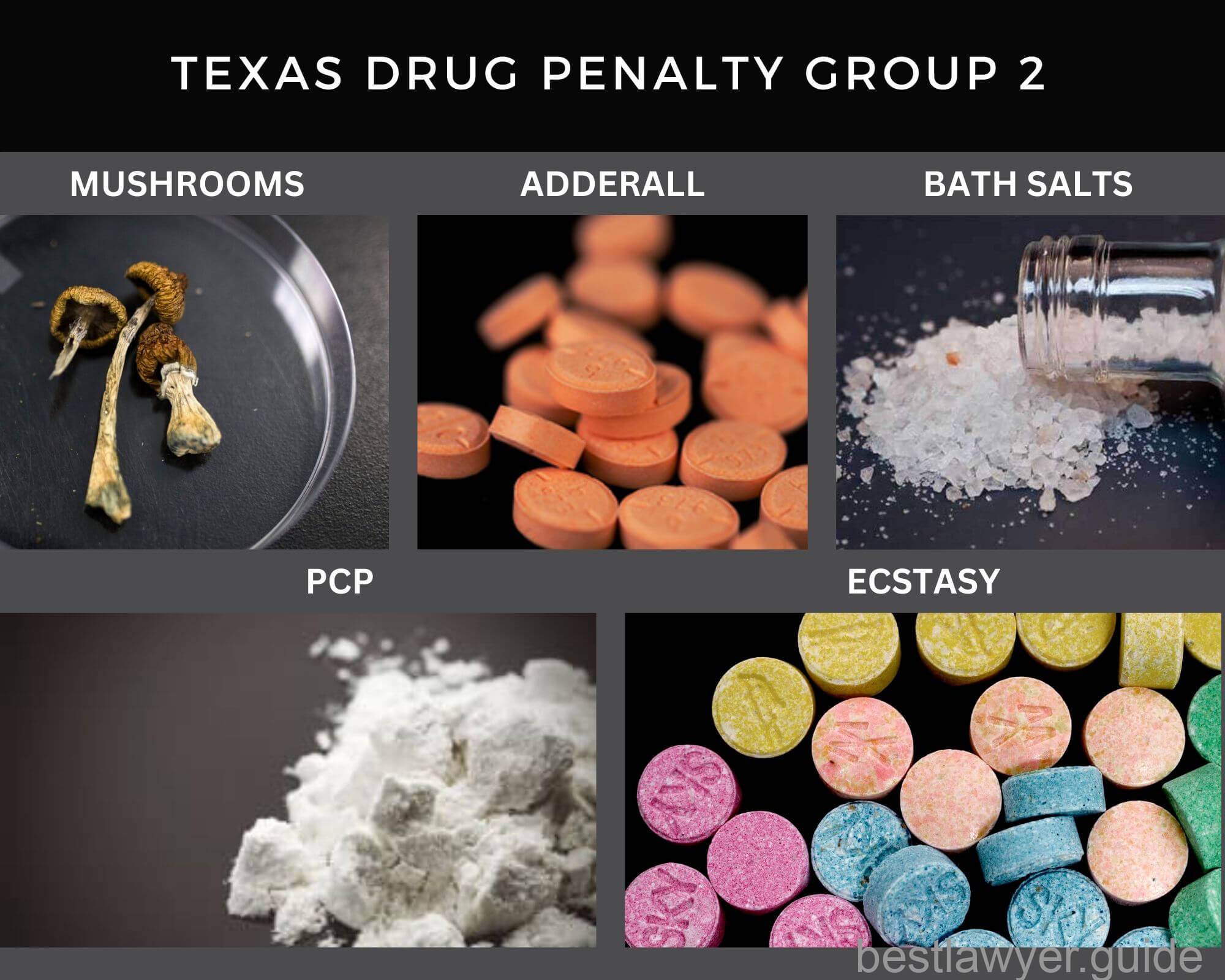Texas Drug Penalty Group 2
Contents
- Texas Drug Penalty Group 2
- Penalty Group 2 drugs – “Poss CS PG 2”
- Manufacturing, Possession with Intent to Deliver, or Delivery
- Improvement for Damage or Death
- Enhancement for Children’s Crimes
- Simple Possession Penalties
- State versus Federal Drug Crime
- Penalty Groups in Texas
- Poss CS PG 2 Common Searches & Code Explanations
- What a Drug Lawyer Can Do to Help
The type of restricted substance used in the offense affects the punishment for drug crimes in Texas. Other than marijuana, most restricted substances are included in a “penalty group.”
The letters PG stand for “penalty group,” and there are six categories labeled PG1, PG1-A, PG2, PG2-A, PG3, and PG4. The classification and punishment for each of these penalty categories differ depending on whether the offense is one of manufacture, delivery, or possession. Penalties reflect the reality that possession is typically classified as one degree lower than manufacturing or delivering the same amount of drugs.
Penalty Group 2 drugs – “Poss CS PG 2”
Ecstasy, mescaline, PCP, and any isomers or salts connected to these restricted compounds are included in this group. The Texas Health & Safety Code law 481-116 states that the minimum fine is $10,000 and that the maximum sentence is 180 days to two years in federal prison or both.

Penalty Group 2’s controlled substances are typically categorized as stimulants or hallucinogens. Other medications included in Penalty Group 2 include:
- PCP
- Ecstacy
- Mescaline
- Psilocybin (mushrooms) (mushrooms)
- Alternative tetrahydrocannabinol (THC) to marijuana
- Many amphetamines
Penalty Group 2 also includes “analogs” of Penalty Group 2 medicines, which are designed medications that are chemically comparable to a listed substance and have similar effects.
Possession of a controlled substance is subject to different punishments than delivery, production, or control with the intent to deliver. However, offenses involving many narcotics mentioned in Penalty Group 2 are always subject to minimum terms.
Manufacturing, Possession with Intent to Deliver, or Delivery
The weight of the controlled substance involved in the offense determines the potential punishment for delivery, possession with intent to deliver, or production of a controlled substance in Penalty Group 2.
- Under one gram. The offense is a felony with a state prison penalty of at least 180 days and up to two years.
- Less than 4 grams but at least 1 gram. The offense is a second-degree felony, with a term of up to 20 years in jail but not less than two years.
- Less than 400 grams but at least 4 grams. The offense is a first-degree felony, with a maximum punishment of 99 years in prison or a mandatory life term.
- 400 or more grams. The maximum term for the offense is 99 years in jail, although it can even result in a life sentence.
Improvement for Damage or Death
The offense is elevated by one degree if a controlled substance that the defendant gave causes death or significant injury unless
- the crime is a felony in the first degree, or
- the maximum punishment for the crime is life in prison.
Enhancement for Children’s Crimes
if an individual under 18 was involved in the crime’s commission. Unless — the offense is elevated by one degree.
- The offense is a felony in the first degree, and
- the maximum punishment is life in prison.
If using force or the threat of using power forced a person under the age of 18 to take part in the crime. Unless the offense is a first-degree felony.
- The offense is already a felony in the first degree,
- and the maximum punishment is life in prison.
The maximum penalty may be increased if the offense includes distribution to a kid.
Simple Possession Penalties
The amount of the drug in possession determines the potential punishment for possessing a controlled substance included in Penalty Group 2.
- Under one gram. It’s a felony punishable by state prison, and A sentence of not less than 180 days nor more than two years may be used as punishment.
- Less than four grams but at least one gram. It is a felony of the third degree, and A prison term of not less than two years nor more than ten years may be used as punishment.
- Less than 400 grams but at least 4 grams. A second-degree felony was committed. Carries a sentence of incarceration of not less than two years or more than twenty years.
- 400 grams or more. A prison term of 99 years or more is the maximum sentence that can be imposed for this crime, Also through a life sentence.
State versus Federal Drug Crime
Given the federal schedules, punishments, and state penalty groups, how can you tell whether a charge is a state or federal criminal? Most drug offenses are treated as state crimes in each State, which might not be the case in a few specific situations. Suppose you are found in possession of any of these narcotics and are also
- captured crossing a state or international border or
- involved with a gang or criminal organization. In that case,
you may be charged on a federal level. Alternatively, national laws and sanctions will apply to your case if the State decides to bring a claim against you in a federal court.
Penalty Groups in Texas
The punishments for a drug crime are determined in Texas using penalty groups. Each punishment group is divided into subgroups based on its medical applications and abuse potential. The Texas Restricted Substances Act’s specified penalty classes for controlled substances are listed in Texas Penal Code 481.102.
Penalty Group 1
Drugs classified in penalty category 1 have a very high risk of misuse and no legitimate medical use. Drugs under penalty group 1 typically carry the worst punishments.
Methadone, cocaine, oxycodone, fentanyl, methamphetamines, ketamine, morphine, heroin, desmosine, or “Krokodil,” and various forms of codeine are a few examples.
Lysergic acid diethylamide is a prohibited substance that is only subject to penalty group 1-A. (LSD). There is little to no medical use for LSD, and it has a substantial dependency risk.
Penalty Group 2 and 2-A
Controlled substances for penalty group 2 have a strong potential for chemical dependency and some medical use, according to penalty groups two and 2-A. Specifically designated as “spice,” synthetic cannabinoids fall under penalty group 2-A.
Examples include tetrahydrocannabinol other than marijuana, MDMA or ecstasy, psilocin (mushrooms), amphetamine, and mescaline.
Penalty Group 3
Drugs found in punishment group 3 have a moderate potential for abuse and, in some cases, may be utilized for medicinal reasons. The majority of chemicals discovered in category three are often categorized as depressants.
Anabolic steroids, pentobarbital, alprazolam (Xanax), methylphenidate (Ritalin), lorazepam (Ativan), peyote, and diazepam (Valium) are a few examples.
Penalty Group 4
All substances in this category of medications, such as Tylenol’s codeine, contain trace amounts of narcotics. Most controlled substances discovered under penalty category 4 have medicinal use and little chance of becoming addicted.
Poss CS PG 2 Common Searches & Code Explanations
“Poss CS” stands for “Possession of a Controlled Substance,” and “PG 2” refers to Penalty Group 2. In the context of drug offenses, Penalty Group 2 typically includes substances that have a moderate potential for abuse and may have medical uses but are subject to state regulation due to their abuse potential. This can include drugs like hallucinogens, stimulants, and other substances listed in Penalty Group 2 in the Texas Controlled Substances Act.
Poss CS PG 2 1g
This phrase indicates the offense of “Possession of a Controlled Substance” in Penalty Group 2 in Texas, where the quantity of the controlled substance in possession is 1 gram.
Poss CS PG 2 = 4g 400g
This phrase suggests that the offense involves possession of a controlled substance listed in Penalty Group 2 and that the quantity of the substance in possession ranges from 4 grams to 400 grams.
Poss CS PG 2 = 4g 400g Penalty Texas
This indicates that the offense of possession of a controlled substance in Penalty Group 2, with quantities ranging from 4 grams to 400 grams, is subject to penalties under Texas law.
Poss CS PG 2 1g in Texas
This phrase reiterates the offense of “Possession of a Controlled Substance” in Penalty Group 2 in Texas but specifies that the quantity in possession is 1 gram.
Poss CS PG 2 = 4g 400g Meaning
This phrase seeks to understand the meaning of the offense of “Possession of a Controlled Substance” in Penalty Group 2 in Texas with quantities ranging from 4 grams to 400 grams.
Poss CS PG 2 – What Kind of Drug?
This question is asking about the type of drug that falls under Penalty Group 2 for possession offenses. As mentioned earlier, Penalty Group 2 drugs include various substances like hallucinogens and stimulants.
Poss CS PG 2 Less Than One Gram
This indicates the offense of possession of a controlled substance listed in Penalty Group 2, but in this case, the quantity is less than one gram.
Poss CS PG 2 1g Meaning
This phrase refers to the offense of “Possession of a Controlled Substance” in Penalty Group 2 (PG 2) in Texas, where the quantity of the controlled substance in possession is 1 gram (1g). The meaning of this phrase is that a person has been found or charged with possessing 1 gram of a controlled substance listed in Penalty Group 2, which includes various drugs with a moderate potential for abuse and medical use restrictions.
Poss CS PG 2 1g (SJF) (DC)
This phrase further describes the specific details of the offense. Here’s what the abbreviations stand for:
- “SJF” refers to “State Jail Felony,” which is a classification of felony offenses in Texas. State jail felonies are less serious than higher-degree felonies but still carry significant penalties.
- “DC” likely refers to “Deferred Adjudication,” which is a type of probation in Texas where a defendant pleads guilty or no contest to the charges, and the judge defers a final judgment of guilt. If the defendant successfully completes the probationary period, the case may be dismissed, and they may avoid a formal conviction on their record.
So, “Poss CS PG 2 1g (SJF) (DC)” indicates that the person has been charged with or found guilty of possessing 1 gram of a controlled substance in Penalty Group 2, and the offense is classified as a State Jail Felony. Additionally, they may have been offered or are seeking Deferred Adjudication as a potential outcome for their case. It’s important to remember that the legal implications and potential penalties can be significant in such cases, and it’s advisable to consult with a qualified attorney for proper legal advice and representation.
What a Drug Lawyer Can Do to Help
Drug cases are complex regardless of the type of crime, the number of drugs involved, or the general circumstances of the crime. It is crucial to discuss your case with a skilled criminal defense trial attorney if you have been accused of a drug felony. It’s frightening for anyone to commit one of these offenses because the punishments are severe, but being aware of your alternatives can be comforting.
Possession or supply of medicines classified as Penalty Group 2 in Texas may result in severe sanctions. Contact a skilled drug lawyer so they can defend you against these accusations rather than taking any chances.




